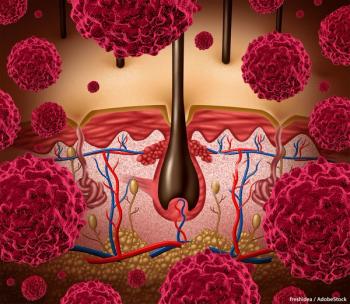
Oncology NEWS International
- Oncology NEWS International Vol 9 No 8
- Volume 9
- Issue 8
Histamine + IL-2 Improves Melanoma Survival
PITTSBURGH-An immunomod-ulating agent, histamine dihydrochloride (Maxamine), used in combination with interleukin-2 (IL-2) may improve survival in certain patients with stage IV malignant melanoma.
PITTSBURGHAn immunomod-ulating agent, histamine dihydrochloride (Maxamine), used in combination with interleukin-2 (IL-2) may improve survival in certain patients with stage IV malignant melanoma.
In a phase III multicenter study, 305 patients with advanced melanoma, were randomized to receive the histamine/
IL-2 combination or IL-2 alone. Those receiving the combination showed a trend toward improved overall survival; increased survival rates at 12, 18, and 24 months; and improved time-to-disease progression, compared with IL-2 alone.
Improvement in survival was statistically significant in patients with metastatic liver disease, a patient population that historically has had a very poor prognosis.
The study is the first well-controlled, multicenter phase III trial to show a significant increase in survival among patients with advanced metastatic melanoma, Sanjiv S. Agarwala, MD, said at a press briefing. Dr. Agarwala, lead investigator for the study and associate medical director, Melanoma Center, University of Pittsburgh Cancer Institute, presented the results at the Perspectives in Melanoma IV Meeting.
Less Toxicity with Lower Doses
All patients in the study received IL-2 in doses lower than in regimens previously approved for IL-2. These lower doses resulted in substantially less toxicity and allowed the patients to take the treatment at home. The combination of IL-2 and histamine was well-tolerated, and most patients maintained a good quality of life, Dr. Agarwala said. Less than 10% had grade 3-4 toxicities.
High-dose IL-2 administered in a hospital, usually in intensive care, is extremely toxic and very expensive, Dr. Agarwala noted. We have, therefore, been looking for a way to use this agent more effectively and to lower its toxicity.
In the study, the first dose of IL-2 was administered in the outpatient clinical setting to make sure the first dose went well, Dr. Agarwala said, and then patients were given instructions, syringes, and drugs to take home. Family members were taught how to help with the administration, and home care nursing went to the patients homes to supervise the first three or four injections.
Once on their own, patients were asked to keep a detailed diary of events, including the schedule of drug administration and toxicity. Follow-up included weekly phone calls and outpatient clinic visits at least once every 2 to 4 weeks.
Patients in both arms followed the same dosing schedule for IL-2, receiving 4 weeks of therapy, followed by a 2-week break, for a total cycle duration of 6 weeks. During weeks 1 and 3, patients received 9 million U/m² twice daily on Monday and Tuesday. During weeks 2 and 4, they received 2 million U/m² twice daily on Monday through Friday. Patients randomized to receive histamine did so on Monday through Friday on weeks 1 to 4. Patients completed a minimum of two cycles and a maximum of eight.
The rationale for the dose schedule was based on preclinical work showing that alternating high and lower doses can maximize the immune effect and make toxicities much more manageable.
Histamine enhances the activity of IL-2, Dr. Agarwala said, by acting on T cells and natural killer (NK) cells within a tumor. These are the common pathways for the action of IL-2, he said. The problem is that in the tumor, these cells are inhibited by toxic oxygen metabolites that are normally produced by macro-phages and neutrophils. Histamine removes those toxic oxygen metabolites and therefore allows the IL-2 to work more effectively upon the T cells and NK cells.
Improvement in Survival
The patients treated with IL-2 and histamine showed a trend toward improved overall survival (P = .1255), Dr. Agarwala said (see Table).
However, when looking at the patients with liver metastases129 patients in this trialthere was a major improvement in survival for patients treated with IL-2 and histamine vs IL-2 alone (P = .004), Dr. Agarwala said. For these patients, median survival was 283 days for those on the combination regimen, compared with 154 days for IL-2 alone.
Among those patients who completed at least two cycles of therapy, there was a significant improvement in survival for the patients treated with Il-2 plus histamine (P = .03), Dr. Agarwala said.
For patients treated at centers that had experience with the regimen, ie, centers that treated seven or more patients on the study, once again there is a significant improvement in survival for those patients treated with IL-2 and histamine vs IL-2 alone, he said.
In the future, investigators should think about how to extend the results of the trial to patients who have a higher risk of liver disease than those with cutaneous melanomas, said John M. Kirkwood, MD, director, Melanoma Center, University of Pittsburgh Cancer Institute. As an example, he mentioned patients with ocular melanoma.
He pointed out that there are cytokines other than IL-2 that could be rationally used in combination with histamine. I think that many of these new disease settings, as well as many of these new combinations with other cytokines, are very worthy topics for further extended evaluation of this agent.
Articles in this issue
over 25 years ago
Scientists Identify Gene Mutations in Multiple Myelomaover 25 years ago
Single-Agent Herceptin Active in Metastatic Breast Cancerover 25 years ago
Brain Metastases Respond to Paclitaxel, Carboplatin, and Brain RTNewsletter
Stay up to date on recent advances in the multidisciplinary approach to cancer.

















































































